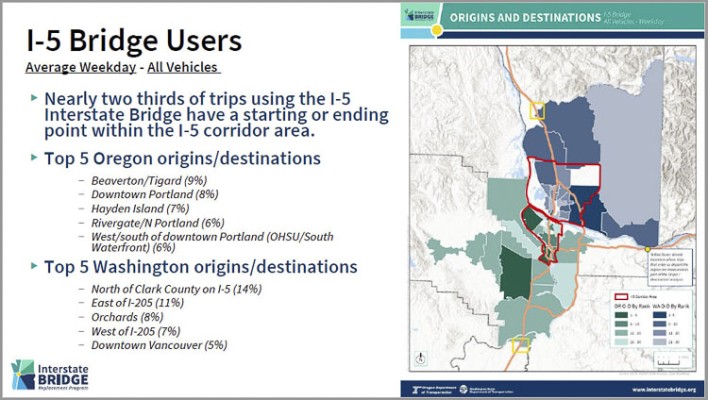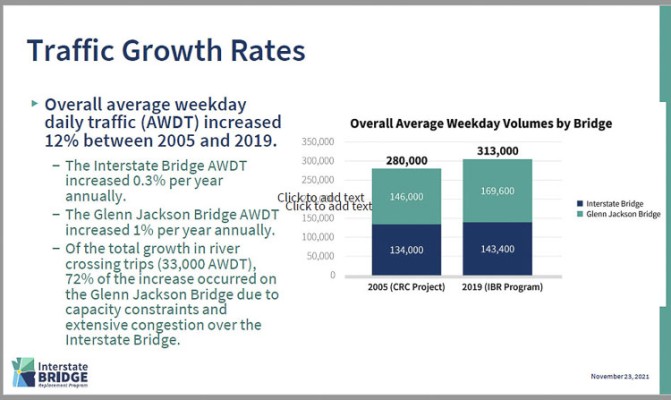Expense, failed ridership projections at heart of opposition to light rail
The “no” voices came out quickly following Thursday’s announcement that extending TriMet’s MAX light rail into Vancouver is the preferred choice by Interstate Bridge Replacement (IBR) staff and Administrator Greg Johnson’s team. The IBR team recommended light rail over using bus rapid transit (BRT) for the transit portion of the project, with a terminus at Evergreen Blvd.
C-TRAN CEO Shawn Donaghy said he believes this is a better location for connecting bus and BRT passengers with light rail than the downtown Turtle Place, which the city of Vancouver has spent millions to develop. Donaghy believes the “running I-5” scenario is best, rather than going on downtown Vancouver streets.
Radio host Lars Larson lambasted the project’s choice of light rail in his Friday morning commentary. Congresswoman Jaime Herrera Beutler chastised the elimination of bus rapid transit, highlighting the fact that voters have repeatedly rejected light rail coming into Clark County. Rep. Vicki Kraft (Republican, 17th District) also blasted the waste of money and expressed concerns about the “double tolls” Southwest Washington residents would be paying.

Overwhelmingly, people on both sides of the river want to save travel time and reduce traffic congestion. That desire has been reflected in every citizen survey the IBR has taken. The 2018 PEMCO survey indicated 94 percent of people in the Portland metro area prefer to use their cars.
Overall, the proposal indicates that after spending up to $5 billion, morning commute times for Clark County residents using I-5 could double. Presently, it takes 16 minutes to go from 99th Street to Victory Blvd. In 2045, it could take either 33 minutes if only one auxiliary lane is added, or 31 minutes if a second auxiliary lane is added to the bridge.
For longer distance travel, the IBR reports a 29-minute travel time from the I-205 interchange in Vancouver to the I-405 interchange on the north end of the Rose Quarter. The projection by 2045 would also double to either 60 minutes or 57 minutes, depending on the number of auxiliary lanes. The Rose Quarter bottleneck remains the real problem on I-5.
Rep. Kraft said there will be no significant reduction in commute times, as a result of the $5 billion expenditure. She worries about “double tolls” that would be charged by the bridge project and Oregon’s congestion pricing scheme, harming the tens of thousands of Southwest Washington citizens who commute to work in Oregon.
Herrera Beutler issued the following statement Thursday after I-5 bridge replacement officials advanced two final projects that exclude bus rapid transit, and would extend Portland’s light rail system into Clark County.
“I could not be more disappointed by today’s announcement that I-5 bridge replacement officials are advancing two final project options that do not include Bus Rapid Transit, while both would extend Portland’s light rail system into Clark County. This decision flies in the face of Southwest Washington voters who have soundly and repeatedly rejected bringing Portland’s light rail to Washington state along with the massive cost, river traffic limitations and public safety concerns that come with it. I detailed these major problems with light rail to project leadership earlier this week.
“For months I have been warning that this process was too closely reflecting the bungled “Columbia River Crossing” failure that collapsed in large part because of its stubborn insistence on light rail, but somehow here we go again. In the ten years since that project failed, Clark County has built up a robust Bus Rapid Transit system that offers a viable mode of interstate transit for a new I-5 bridge – yet the Interstate Bridge Group won’t even study BRT among its final options.”
The IBR team has previously reported that mass transit carries only 1.7 percent of daily trips over the current Interstate Bridge. The team members cite undisclosed “models” that predict increased transit ridership up to 11 percent of trips This flies in the face of regional transit ridership having been in decline for a decade on TriMet, and two decades at C-TRAN.
In 2019, prior to the pandemic lockdown, C-TRAN had about 1.7 million fewer passenger boardings than in 1999. The IBR team used a 14-year-old study as justification for its decision, saying light rail had 19 to 25 percent more riders.

Larson blasted the resurrection of the failed Columbia River Crossing (CRC) project Friday morning. He specifically called out Vancouver Mayor Anne McEnerny-Ogle.
“Elected elites have no right to jam billion dollar light rail to Vancouver down the throats of voters and I plan to fight it,” he said.
“Yesterday, the usual suspects saw Joe Biden’s visit to the Northwest as the perfect opportunity to announce that they will tie light rail we don’t need, to an Interstate 5 Bridge we do need,” he said.
Larson listed five major points on why sensible people should oppose light rail.
- Light rail killed the last Columbia River I-5 bridge replacement after 10 years of effort and $200-million wasted taxpayer dollars that only produced a pile of studies.
- Vancouver voters said no to light rail the last time they were allowed to vote.
- Tigard voters said no to light rail on their last vote. Elites in office are doing it anyway, at more than $3 billion in cost for a project that’s literally shrinking while they build it .
- Light rail costs about 20 times as much money as a comparable high speed bus system.
- Buses can go anywhere. Rail cannot.
“Yet the usual suspects, C-TRAN, the failing TriMet with its exaggerated promises of ridership, disproven for decades, and Vancouver’s Mayor Anne Ogle, have decreed that citizens will embrace this failed 19th century technology, and pay for it and accept the lies that always go with it,” Larson said. “I propose we tell these people to pound sand.”
“The question has to be asked: Does light rail make sense in Clark County?” Senator Lynda Wilson (Republican, 17th District) said responding to a media question.
Bike Portland reported opposition to the project from its community, citing Commissioner Jo Ann Hardesty. She cited concerns about impacts on the climate and also the BIPOC communities. “The question is do we want to increase capacity, and I say no,” she said.
They labeled it as “the I-5 expansion project proposes repeat of CRC, or slightly less wide version.”
Metro President Lynn Peterson indicated she thought the one auxiliary lane option was closest to what the Metro Council, which includes some of the project’s most skeptical voices, has been advocating for. Shaving one auxiliary lane off the project could allegedly save $75-$100 million from the project.
On May 5, there will be another ESG meeting where more details and decisions will be revealed by the IBR staff. Will it be the full blown Columbia River Crossing option, which had two auxiliary lanes? Or will it offer even fewer total lanes?
The 16 bi-state legislators are scheduled to meet the next day for another update. In yesterday’s meeting, Senator Wilson asked again, if the legislators would be allowed to vote on the important choices for the project.
Administrator Johnson said that was not his call, but up to them. None of Wilson’s fellow elected officials spoke in support of her request.
Wilson, said she felt like “the train has left the station.” She said she worried costs of light rail could still fall on Southwest Washington residents’ shoulders.
The failed CRC was killed nearly a decade ago as citizens rose up. They deemed the one-minute improvement in the morning was not a good value for the $3.6 billion cost. They rejected the tolling. And they rejected light rail as a form of transit coming into Clark County.

It remains to be seen if the citizens will rise up this time, as well as more elected officials, and trigger a repeat of the CRC’s demise.
“The real question becomes – if there’s no significant benefit to reducing congestion and commute times, why would elected officials support this project and have the highest official in the nation come out to promote it?” she asked. Kraft also expressed concerns about rising crime rates in general, and what might happen if light rail is extended into Clark County.
Commissioner JoAnn Hardesty of Portland commented yesterday during the ESG meeting, “Behavior modification should be part of the conversation”. Really? A mayor on our side of the river involved with this project has effectively said the same thing. Why should elected officials be trying to get you to “modify your behavior”? They want you to do what they want you to do, instead of you exercising your freedom.




